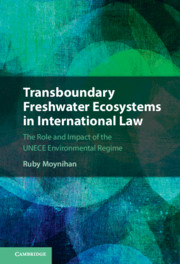 Transboundary Freshwater Ecosystems in International Law
Transboundary Freshwater Ecosystems in International Law Published online by Cambridge University Press: 01 October 2021
There is a pressing need to strengthen systemic integration and mutually supportive interpretation of norms and institutional coordination between the UNECE environmental agreements with a view to understanding their collective contribution to clarifying and further developing international water, environmental and general international law. This chapter identifies the contribution of the UNECE regime to established ‘central or cornerstone rules and principles’ of international water law, including the due diligence rule to avoid or mitigate transboundary harm, the duty to cooperate, the principle of equitable and reasonable use and transboundary environmental impact assessments (EIAs). Key findings demonstrate that these rules and principles are defined in greater detail in the UNECE treaties compared to global treaties, which fills gaps in international law. For example, the UNECE clarifies international law regarding transboundary EIAs by providing criteria to identify what level of risk triggers the obligation to conduct an EIA and compulsory minimum content of EIAs. The UNECE regime also clarifies the effect of applying general principles, like the precautionary and polluter pays principles to the ‘no harm’ rule which strengthens these obligations. The strengths and weaknesses of UNECE’s contribution to developing reporting mechanisms for the Sustainable Development Goals, especially SDG 6 on water, are discussed.
To save this book to your Kindle, first ensure no-reply@cambridge.org is added to your Approved Personal Document E-mail List under your Personal Document Settings on the Manage Your Content and Devices page of your Amazon account. Then enter the ‘name’ part of your Kindle email address below. Find out more about saving to your Kindle.
Note you can select to save to either the @free.kindle.com or @kindle.com variations. ‘@free.kindle.com’ emails are free but can only be saved to your device when it is connected to wi-fi. ‘@kindle.com’ emails can be delivered even when you are not connected to wi-fi, but note that service fees apply.
Find out more about the Kindle Personal Document Service.
To save content items to your account, please confirm that you agree to abide by our usage policies. If this is the first time you use this feature, you will be asked to authorise Cambridge Core to connect with your account. Find out more about saving content to Dropbox.
To save content items to your account, please confirm that you agree to abide by our usage policies. If this is the first time you use this feature, you will be asked to authorise Cambridge Core to connect with your account. Find out more about saving content to Google Drive.